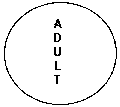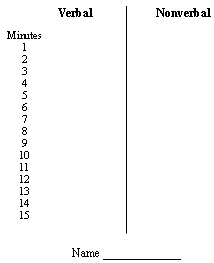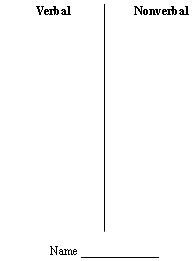ESE548 : The Class : Commander Troy : Pat : Effective Conversing |
||||||
Effective Conversing
Berne (1964) suggested that each time one person acknowledges another a transaction occurs. The quality of the exchange depends on how that unit of human communication touches each life. To measure the transcation, we look at what role or ego state the person's verbal or nonverbal expression comes from. We can also see if the responses are equally satisfying, and if they provide complementary need satisfaction for both participants.
| Parents Refers To A Person's Values And Rules | ||
| Nurturing Parent is understanding and helpful. Too much NP gives a smothering feeling followed by
a desire to withdraw.
NP "Where were you last time?" |
 |
Critical Parent is directive and judgemental. Limit setting, rule enforcement and concern for well
being are included. Too much CP feels like a dictatorship.
CP "Why weren't you here last time?" |
| Adult Refers To A Person's Cognitive Information Processes | ||
| Adult is fact oriented. The messages are logical, based on observable data or evidence that is clear and it is presented in a linear fashion. It is a vital component of thinking and being rational. |  |
Adult "Our topic for today is ..." Non verbal - attentive posture, frank expression |
| Child Refers To A Person's Spontaneous And Impulsive Nature | ||
| Free Child is impulsive pleasure seeking, untrained and autonomous.
FC "Let's go over the Union and get something to eat for our group meeting." |
 |
AC "We've better not share answers. We might get in trouble." Non verbal - anxious or passive, worried looking, wringing hands |
| The sense of being understood is very powerful and rather rare - Van Kaam | One cannot explain things to unfriendly people - Freud | |
Transcation can be an important way to monitor the power issues in communicating. Each pattern tells about the relationship between two people. It is also a useful way to change the way we relate to each other.

When communicating is effective, it builds relationship and meets needs. Each person feels more understood and primary needs are honored.
- Assume the role of teacher in a classroom and provide an example of each kind of statement.



Nuturing Parent ____________________________________________________________________________ Controlling Parent ____________________________________________________________________________
Adult ____________________________________________________________________________
Free Child ____________________________________________________________________________
Adapting Child ____________________________________________________________________________
- Take turns being the social leader and monitoring group interactions. Record each verbal transaction and try to keep a record of nonverbal transactions, too. Every fifteen minutes, stop and share the findings. Summarize the outcome and discuss how to create optimum conditions for effective conversing.
Trasaction Record



Adult - % of time - with whom - what did you say? What makes you switch?
Child - % of time - with whom - what did you say? What makes you switch?
Once you have finished you should:
Go back to Lesson 2
E-mail J'Anne Ellsworth at Janne.Ellsworth@nau.edu
Copyright © 2000 Northern Arizona
University
ALL RIGHTS RESERVED